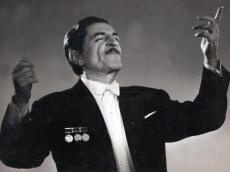|
|
TODAY.AZ / Arts & Entertainment
Maestro Niyazi: Genius conductor and fashion icon
22 August 2022 [14:53] - TODAY.AZ

By Azernews
By Laman Ismayilova
The Azerbaijani school of conductors has gone a long way in development. The art of conducting is inseparably connected to maestro Niyazi.
In fact, Niyazi Tagizada-Hajibayov was the first professional Azerbaijani conductor, who won world fame for Azerbaijan.
His name marks a whole era in the history of the Azerbaijani musical art.
The great conductor grew up in an extremely musical atmosphere. There was a lot of music and singing around thanks to Niyazi's uncle, music genius Uzeyir Hajibayli.
With bated breath, the young talent admired the music pieces performed by his father- Zulfugar Hajibayli, another outstanding composer. The childhood spent in such a creative environment made itself felt.
Niyazi Tagizada-Hajibayov received his primary musical education in Baku.
Furthermore, he studied at the Gnessin Music School (1925-1926) in Moscow and the Central Musical Technical School (1929-30 ) in Saint Petersburg.
The first big success came to Niyazi in 1938 at the Days of Azerbaijan Art in Moscow. He conducted Uzeyir Hajibayli's Koroghlu and Muslim Magomayev's Nargiz operas.
Maestro Niyazi's musical talent was truly impressive. The maestro conducted the Azerbaijan State Symphony orchestra for 46 years.
His orchestra accompanied such legendary singers as Bulbul, Rashid Behbudov, Muslim Magomayev, Lutfiyar Imanov, and other outstanding performers.
Niyazi's most significant works include the opera Khosrov and Shirin (1942), and the ballet Chitra (1960). His symphonic mugham Rast achieved worldwide success.
He also wrote a number of major epic pieces in the 1940s.
His military-themed music Memoirs and In the battle were included in the program of the Decade of music of the Caucasus republics in 1944.
In 1945, Niyazi carried out a new musical edition of this musical comedy The Cloth Peddler.
Artistic director and chief conductor of the Azerbaijan State Symphony Orchestra Niyazi was also active in organizing symphony concerts and festivals in Shusha, Khankandi, Agdam, Agjabadi, Barda, and other regions.
"The propagation of classical music has a strong influence on the general culture, the spiritual world, and the musical taste, especially on the younger generation. Properly constructed musical propaganda can solve this urgent problem," Niyazi once said.
Niyazi conducted many of the major symphony orchestras in Prague, Berlin, Budapest, Bucharest, New York, Paris, Istanbul, and London, successfully promoting Azerbaijani classical music.
Many contemporaries said about Niyazi that he was a trendsetter in fashion. At that time, conductors went on stage in a tailcoat, special shirts, and bow ties. Maestro Niyazi wore a white turtleneck under a tailcoat which became his trendy look.
The maestro died on August 2, 1984, in Baku and was buried in the Alley of Honor.
The Home Museum of the great conductor and composer was founded in 1994. Maestro Niyazi lived and worked here from 1958 to the end of his life.
Over 6,200 exhibits, including Niyazi's musical manuscripts, photographs, books, and printed music from his personal library, gramophone records, and personal belongings are included in the museum's collection.
The Niyazi House Museum regularly hosts concerts dedicated to the maestro as well as the significant dates taken place in the musical history.
URL: http://www.today.az/news/entertainment/224448.html
 Print version
Print version
Connect with us. Get latest news and updates.
See Also
- 24 April 2025 [13:14]
Lecture on Mirza Kadim Irevani's legacy delivered in Kyrgyzstan - 24 April 2025 [12:19]
Book by national writer presented in Kyrgyzstan - 23 April 2025 [14:51]
Gala State Reserve marks its 37th anniversary with tree planting campaign - 23 April 2025 [11:43]
State Philharmonic Hall pays tribute to eminent composer - 22 April 2025 [14:15]
Int'l Jazz Day in Baku to celebrate freedom and inspiration - 22 April 2025 [13:11]
Baku, Tashkent to hold joint art projects - 22 April 2025 [11:05]
Leyla Aliyeva meets with spouse of Secretary General of Central Committee of Vietnam's Communist Party - 22 April 2025 [10:41]
Culture Minister meets with Kyrgyz counterpart in Bishkek - 21 April 2025 [15:38]
Festival in Masalli embraces arts and fosters creative expression - 21 April 2025 [14:33]
Film about Garabagh War premiered in Nizami Cinema Center
Most Popular
 Culture Minister meets with Kyrgyz counterpart in Bishkek
Culture Minister meets with Kyrgyz counterpart in Bishkek
 Trump sees hope for Ukraine-Russia deal, analysts remain skeptical
Trump sees hope for Ukraine-Russia deal, analysts remain skeptical
 Azerbaijan's Chamber of Accounts urges strengthening audits on renewables & green budgeting
Azerbaijan's Chamber of Accounts urges strengthening audits on renewables & green budgeting
 Azerbaijan and China sign mutual visa exemption agreement for ordinary passport holders
Azerbaijan and China sign mutual visa exemption agreement for ordinary passport holders
 Oil exports from Azerbaijan to Tabriz may be on agenda during Pezeshkian's visit to Baku
Oil exports from Azerbaijan to Tabriz may be on agenda during Pezeshkian's visit to Baku
 Israeli media spotlights Azerbaijan’s rising regional clout as strategic Eurasian mediator
Israeli media spotlights Azerbaijan’s rising regional clout as strategic Eurasian mediator
 Leyla Aliyeva meets with Vice-President of Vietnam to expand humanitarian and cultural ties
Leyla Aliyeva meets with Vice-President of Vietnam to expand humanitarian and cultural ties
